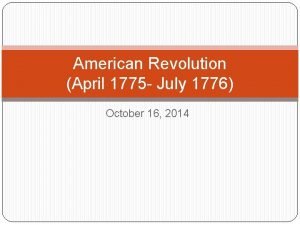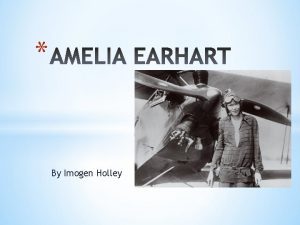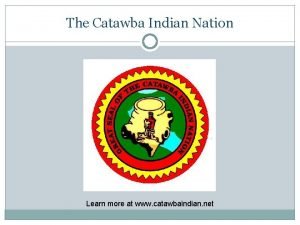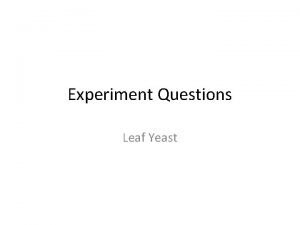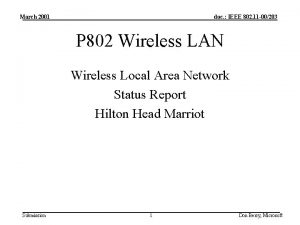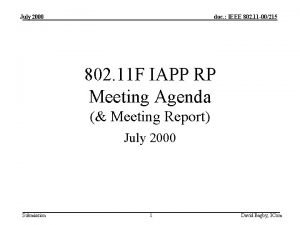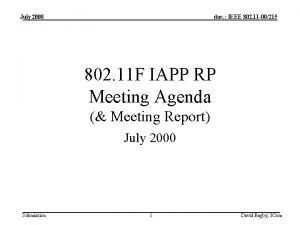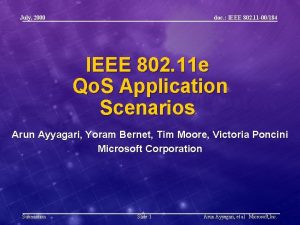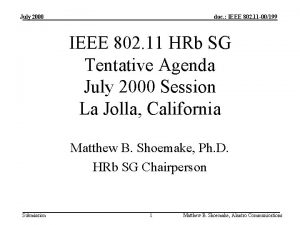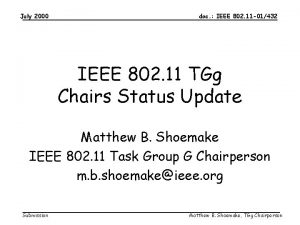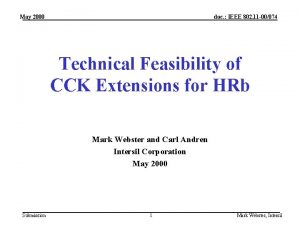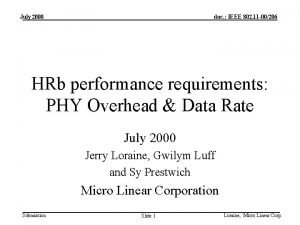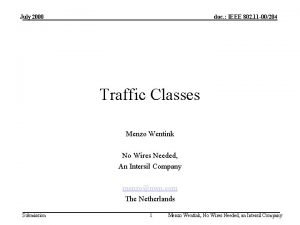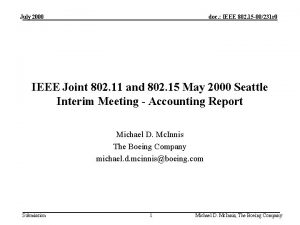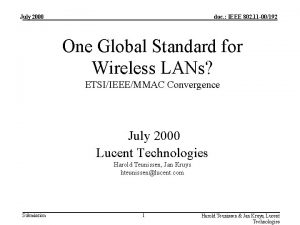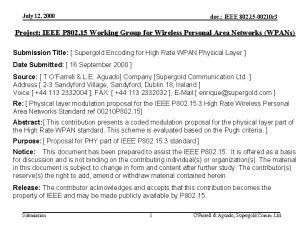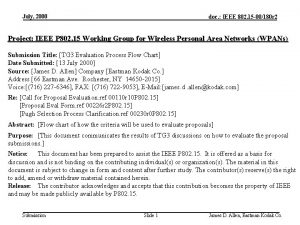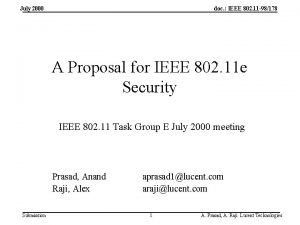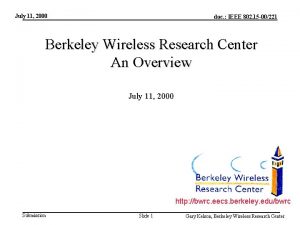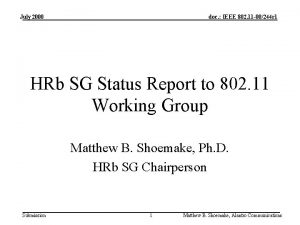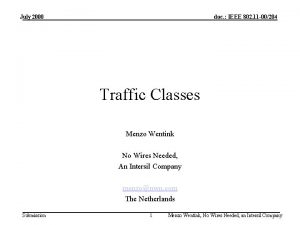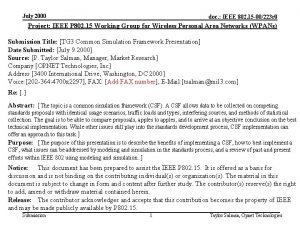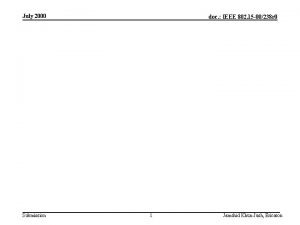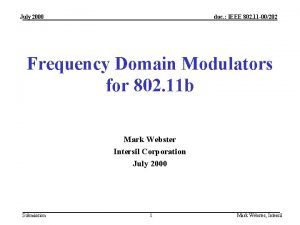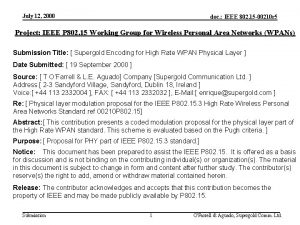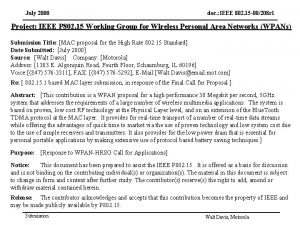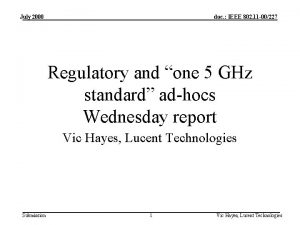July 2000 doc IEEE 802 11 00203 Technical




























- Slides: 28

July 2000 doc. : IEEE 802. 11 -00/203 Technical Feasibility of OFDM for HRb Mark Webster, Steve Halford and Carl Andren Intersil Corporation July 2000 Submission 1 Mark Webster, Intersil

July 2000 doc. : IEEE 802. 11 -00/203 Why Consider OFDM for 802. 11 HRb? • OFDM was selected as the best high-rate waveform by both IEEE 802. 11 a and HIPERLAN BRAN • OFDM was considered superior for providing multiple high-data-rates with reasonable complexity while providing good performance for both high-multipath and low-SNR conditions. • FCC processing-gain capability for OFDM is equivalent to other modulations being considered for HRb. • Reuse of 802. 11 a would speed HRb to market. • Provides standards harmonization: 802. 11 a, HIPERLAN and, now (? ), 802. 11 HRb Submission 2 Mark Webster, Intersil

July 2000 doc. : IEEE 802. 11 -00/203 Multiple HRb OFDM Options Exist Options 1. Use the 802. 11 a symbol structure and 20 MHz timing unmodified. This requires a 802. 11 b/HRb clock change from 11 MHz to 20 MHz. 2. Use the 802. 11 a symbol structure, but use 22 MHz timing. This requires a 802. 11 b/HRb clock change from 11 MHz to 22 MHz. 3. Change the # of pilots from 52 to 48 and use 22 MHz timing. This reduces the spectral occupancy slightly. 4. Use 22 MHz sampling but change guard interval from 16 to 24 samples. This maintains the 802. 11 a’s data rates. 5. Etc. This presentation addresses only option 2, since it appears to be the simplist for HRb. Submission 3 Mark Webster, Intersil

July 2000 doc. : IEEE 802. 11 -00/203 Key Features • Use 802. 11 a’s OFDM symbol structure unmodified. • Stay consistent with 802. 11 b’s chip rate of 11 MHz. • For HRb OFDM, increase 802. 11 a’s 20 MHz sample rate by 10% to 22 MHz, which is double the 802. 11 b chip rate. • Provides data rates 10% higher than 802. 11 a’s: 6. 6, 9. 9, 13. 2, 19. 8, 26. 4, 39. 6, 52. 8, 59. 4 Mbps. • Spectrum is 10% wider than 802. 11 a’s. Submission 4 Mark Webster, Intersil

Trade Matrix July 2000 doc. : IEEE 802. 11 -00/203 802. 11 a and 802. 11 HRb Comparison Matrix Modifications to 802. 11 a’s parameters are shown in red. Submission 5 Mark Webster, Intersil

802. 11 a OFDM Symbol July 2000 doc. : IEEE 802. 11 -00/203 OFDM Symbol Using 20 MHz Sampling Fundamental 20 MHz x 4 usecs = 80 samples 4 usecs OFDM Symbol Guard Interval IFFT/FFT SPAN 16 Samples IEEE 802. 11 a 64 Samples time ~16. 25 MHz 312. 5 KHz Tone Spacing 52 Subcarriers . . . frequency Submission 6 Mark Webster, Intersil

HRb OFDM Symbol July 2000 doc. : IEEE 802. 11 -00/203 OFDM Symbol Using 22 MHz Sampling Fundamental 80 samples / 22 MHz = 3. 63637 usec 3. 63 usecs OFDM Symbol Guard Interval IEEE 802. 11 a but 22 MHz clock IFFT/FFT SPAN 16 Samples 64 Samples time ~17. 875 MHz 343. 75 KHz Tone Spacing 52 Subcarriers . . . frequency Submission 7 Mark Webster, Intersil

SPECTRAL MASKS July 2000 doc. : IEEE 802. 11 -00/203 Comparing 802. 11 a and 802. 11 b’s Spectral Masks 802. 11 b is Slightly More Restrictive 802. 11 b Spectral Mask 802. 11 a Spectral Mask • Spectral Masks Appear Compatible • Out-of-band regulatory restrictions are extra -20 d. Br -28 d. Br -40 d. Br -30 Submission -20 -11 -9 fc 8 9 11 20 30 Mark Webster, Intersil

SPECTRAL MASKS July 2000 doc. : IEEE 802. 11 -00/203 Corresponding HRb OFDM Spectral Mask -20 d. Br -28 d. Br -40 d. Br -33 Submission -22 -12. 1 -9. 9 fc 9 9. 9 12. 1 22 33 Mark Webster, Intersil

July 2000 Channel Spacing doc. : IEEE 802. 11 -00/203 Comparing 802. 11 a and 802. 11 b’s Channel Spacings 802. 11 b is More Loose 802. 11 b Channel Spacing frequency 25 MHz 2. 4 GHz Frequency Plans Remain Unmodified • Channel Spacings Appear Compatible 802. 11 a Channel Spacing frequency 20 MHz Submission 10 Mark Webster, Intersil

IEEE-802. 11 b PACKET STRUCTURE July 2000 doc. : IEEE 802. 11 -00/203 CURRENT 802. 11 b PREAMBLES 802. 11 b LONG PREAMBLE 144 BITS @ 1 Mbps HEADER 48 BITS @ 1 Mbps PSDU SELECTABLE @ 1, 2, 5. 5 OR 11 Mbps 192 usecs Data Payload 802. 11 b SHORT PREAMBLE 72 BITS @ 1 Mbps HEADER 48 BITS @ 2 Mbps PSDU SELECTABLE @ 2, 5. 5 OR 11 Mbps 96 usecs • 1 and 2 Mbps uses 11 chip BARKER codes. • 5. 5 and 11 Mbps uses 8 chip CCK codes. • Chipping is at 11 MHz. Submission 11 Mark Webster, Intersil

HRb OFDM PACKET STRUCTURE July 2000 doc. : IEEE 802. 11 -00/203 PREAMBLES for 802. 11 HRb: Reuse 802. 11 b preambles Service Field Bit Denotes Switch to OFDM 802. 11 HRb LONG PREAMBLE 144 BITS @ 1 Mbps K usecs HEADER 48 BITS @ 1 Mbps 192 usecs OFDM SYNC OFDM Signal PSDU SELECTABLE OFDM Symbols @ 6. 6, 9. 6, 13. 2, 19. 8, 26. 4, 39. 3, 52. 8 or 59. 4 Mbps 16 usecs 4 usecs Use 802. 11 a’s OFDM sync pattern • Data rate • # bytes of data 802. 11 HRb SHORT PREAMBLE 72 BITS @ 1 Mbps HEADER 48 BITS @ 2 Mbps 96 usecs OFDM SYNC OFDM Signal Data Payload PSDU SELECTABLE OFDM Symbols @ 6. 6, 9. 6, 13. 2, 19. 8, 26. 4, 39. 3, 52. 8 or 59. 4 Mbps 16 usecs 4 usecs Service Field Bit Denotes Switch to OFDM Submission 12 Mark Webster, Intersil

July 2000 doc. : IEEE 802. 11 -00/203 802. 11 b Premable/Header OFDM Sync Detail • • • QUESTIONS 1. Are short and long OFDM syncs necessary? 2. Are they preferred? Signal Detection AGC Diversity Coarse Freq Estimation Timing Synchronization Channel Estimation 16 usecs 4 usecs 802. 11 b PREAMBLE Short Sync t 1 t 2 t 3 t 4 t 5 t 6 t 7 t 8 t 9 t 10 8 usec • • • Submission OFDM SYNC 802. 11 b HEADER Signal Detection AGC Diversity Coarse Freq Estimation Timing Synchronization 13 OFDM Signal Long Sync G 12 T 1 T 2 8 usec • Fine Freq Estimation • Channel Estimation Mark Webster, Intersil

July 2000 doc. : IEEE 802. 11 -00/203 Packet Structure for Long Preamble with OFDM Header: Standard Mode DATA BURST SFD Header 16 bits 1 MBPS 16 usec 48 bits 1 MBPS 48 usec Sync # Bits: Rate: Time: 128 bits 1 MBPS 128 usec Standard IEEE 802. 11 b header Short Sync Long Sync ACK BURST Signal 20 usec Standard IEEE 802. 11 a Header MPDU: X Bytes 8*X bits R MBPS 8*X/R usec IFS Sync SFD Header Short Sync Long Sync 128 bits 16 bits 48 bits 1 MBPS 10 usec 128 usec 16 usec 48 usec OFDM Data Symbols Standard IEEE 802. 11 b header Signal Ack 3 symbols 6 MBPS 12 secs 20 usec OFDM Ack (Uses 3 OFDM symbols) Standard IEEE 802. 11 a Header Throughput = 8*X Mbps/ (128+16+48+20 + 8*X/R+10+128+16+48+ 20 +12) usec This mode uses both IEEE 802. 11 b Long Preamble and IEEE 802. 11 a Preamble to acquire all necessary OFDM parameters Submission 14 Mark Webster, Intersil

July 2000 doc. : IEEE 802. 11 -00/203 Packet Structure for Long Preamble without OFDM Header: Fast Mode ACK BURST DATA BURST Sync # Bits: 128 bits Rate: 1 MBPS Time: 128 usec SFD Header 16 bits 1 MBPS 16 usec 48 bits 1 MBPS 48 usec Standard IEEE 802. 11 b header IFS MPDU: X Bytes 8*X bits R MBPS 8*X/R usec Sync 128 bits 1 MBPS 10 usec 128 usec OFDM Data Symbols SFD 16 bits 1 MBPS 16 usec Header 48 bits 1 MBPS 48 usec Ack 3 Symbols 6 MBPS 12 secs Standard IEEE 802. 11 b OFDM Ack header (Uses 3 OFDM symbols) Throughput = 8*X Mbps/ (128+16+48+8*X/R+10+128+16+48+12) usec This mode uses IEEE 802. 11 b Long Preamble only to acquire all necessary OFDM parameters Submission 15 Mark Webster, Intersil

July 2000 doc. : IEEE 802. 11 -00/203 With-and-Without OFDM Sync Long-Preamble Throughput Comparison Submission 16 Mark Webster, Intersil

July 2000 doc. : IEEE 802. 11 -00/203 Packet Structure for Short Preamble with OFDM Header: Standard Mode DATA BURST SFD Header 16 bits 1 MBPS 16 usec 48 bits 1 MBPS 48 usec Sync # Bits: Rate: Time: 56 bits 1 MBPS 56 usec Standard IEEE 802. 11 b header Short Sync Long Sync ACK BURST Signal 20 usec Standard IEEE 802. 11 a Header MPDU: X Bytes 8*X bits R MBPS 8*X/R usec IFS Sync SFD Header Short Sync Long Sync 56 bits 16 bits 48 bits 1 MBPS 10 usec 56 usec 16 usec 48 usec OFDM Data Symbols Standard IEEE 802. 11 b header Signal Ack 3 symbols 6 MBPS 12 secs 20 usec OFDM Ack (Uses 3 OFDM symbols) Standard IEEE 802. 11 a Header Throughput = 8*X Mbps/ (56 +16+48+20 + 8*X/R+10+56 +16+48+ 20 +12) usec This mode uses both IEEE 802. 11 b Short Preamble and IEEE 802. 11 a Preamble to acquire all necessary OFDM parameters Submission 17 Mark Webster, Intersil

July 2000 doc. : IEEE 802. 11 -00/203 Packet Structure for OFDM Only Header: Super Fast Mode ACK BURST DATA BURST Short Sync Long Sync # Bits: Rate: Time: 8 usec Signal MPDU: X Bytes 4 usec 8*X bits R MBPS 8*X/R usec Standard IEEE 802. 11 a header IFS 10 usec OFDM Data Symbols Short Sync Long Sync 8 usec Signal 4 usec Ack 3 Symbols 6 MBPS 12 usec OFDM Ack Standard IEEE 802. 11 a (Uses 3 OFDM symbols) header Throughput = 8*X Mbps / (8+8+4+8*X/R+10+8+8+4+12) This mode uses IEEE 802. 11 a Preamble to acquire all necessary OFDM parameters Submission 18 Mark Webster, Intersil

July 2000 doc. : IEEE 802. 11 -00/203 With-and-Without OFDM Sync Short-Preamble Throughput Comparison Submission 19 Mark Webster, Intersil

HEADER DETAIL FOR HRb July 2000 doc. : IEEE 802. 11 -00/203 HRb SHORT/LONG-PREAMBLE HEADER DETAIL • Signal Field only accommodates rates up to 25. 5 Mbps ( 8 bits x 100 Kbps, so use a Service Field bit to denote data-rate extensions) SIGNAL 8 BITS SERVICE 8 BITS HEADER 48 BITS LENGTH 16 BITS CRC 16 BITS • The Length Field is adequate, since measured in usecs. • OFDM proposal uses PSDU length in an integer number of usecs. • Use a Service Field bit to denote OFDM mode. • Use a Service Field bit to denote data-rate extensions. Submission • Unchanged 20 Mark Webster, Intersil

July 2000 HRb OPTIONAL MODE: OFDM ONLY doc. : IEEE 802. 11 -00/203 PREAMBLES for 802. 11 HRb: Super-Short OFDM-only Preamble Option • Data Rate • # bytes of data OFDM SYNC SIGNAL SYMBOL 16 usecs 4 usecs Data Payload PSDU SELECTABLE @ 6, 9, 12, 18, 24, 36, 48 or 54 Mbps Not interoperable/coexistent with 802. 11 b Submission 21 Mark Webster, Intersil

July 2000 doc. : IEEE 802. 11 -00/203 Packet Structure for OFDM Only Header: Super Fast Mode ACK BURST DATA BURST Short Sync Long Sync # Bits: Rate: Time: 8 usec Signal MPDU: X Bytes 4 usec 8*X bits R MBPS 8*X/R usec Standard IEEE 802. 11 a header IFS 10 usec OFDM Data Symbols Short Sync Long Sync 8 usec Signal 4 usec Ack 3 Symbols 6 MBPS 12 usec OFDM Ack Standard IEEE 802. 11 a (Uses 3 OFDM symbols) header Throughput = 8*X Mbps / (8+8+4+8*X/R+10+8+8+4+12) This mode uses IEEE 802. 11 a Preamble to acquire all necessary OFDM parameters Submission 22 Mark Webster, Intersil

July 2000 doc. : IEEE 802. 11 -00/203 Throughput of Super-Short Preamble Submission 23 Mark Webster, Intersil

July 2000 doc. : IEEE 802. 11 -00/203 Realistic Impairments and Considerations Not Included in This Throughput Analysis • • • Packet Errors cause retransmission. Packet collisions Integer data length requirement Time for backoff to avoid collision MAC Enhancements Submission 24 Mark Webster, Intersil

July 2000 SIMULATION RESULTS doc. : IEEE 802. 11 -00/203 PERFORMANCE IN AWGN 1000 byte packet-error-rate vs. Eb. No Submission 25 Mark Webster, Intersil

July 2000 SIMULATION RESULTS doc. : IEEE 802. 11 -00/203 PERFORMANCE IN AWGN 1000 byte packet-error-rate vs. SNR Submission 26 Mark Webster, Intersil

July 2000 PA BACK-OFF for OFDM doc. : IEEE 802. 11 -00/203 OFDM has Reasonable PA Backoffs Pa Backoff Example Rapp Model p = 2 16 QAM Subcarriers OBO 3. 9 d. B It is fairly easy to meet the spectral mask. Submission 27 Mark Webster, Intersil

July 2000 doc. : IEEE 802. 11 -00/203 OFDM’s Large Peak Deviations are Rare 16 QAM Subcarriers Theoretical Max Peak-to-Ave Pwr: 22 d. B 22 MHz sample rate Submission 28 Mark Webster, Intersil
 Bridges from 802.x to 802.y
Bridges from 802.x to 802.y Bridges from 802.x to 802.y
Bridges from 802.x to 802.y Ieee 802 family
Ieee 802 family Ieee 802 3 compliance
Ieee 802 3 compliance Ieee 802
Ieee 802 Arquitetura ieee 802
Arquitetura ieee 802 Ieee 802 que es
Ieee 802 que es Ieee 802 standard
Ieee 802 standard Bluetooth ieee 802
Bluetooth ieee 802 802 ieee
802 ieee Ieee 802
Ieee 802 July 16 1776
July 16 1776 The hot july sun beat relentlessly down
The hot july sun beat relentlessly down Ctdssmap payment schedule july 2021
Ctdssmap payment schedule july 2021 July 30 2009 nasa
July 30 2009 nasa Malaga in july
Malaga in july On july 18 2001 a train carrying hazardous chemicals
On july 18 2001 a train carrying hazardous chemicals July 2 1937 amelia earhart
July 2 1937 amelia earhart Hurrah for the fourth of july cartoon
Hurrah for the fourth of july cartoon Ruth bruno
Ruth bruno Uninvited guest harris burdick
Uninvited guest harris burdick Super saturday tribal bingo july 4
Super saturday tribal bingo july 4 July 1969
July 1969 Sources nso frenchhowell neill mit technology...
Sources nso frenchhowell neill mit technology... Leaf yeast experiment
Leaf yeast experiment June 22 to july 22
June 22 to july 22 Poppies in july imagery
Poppies in july imagery 2001 july 15
2001 july 15 July 1-4 1863
July 1-4 1863











